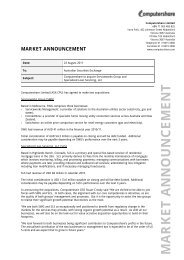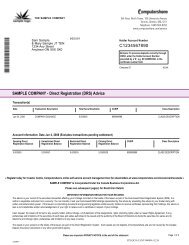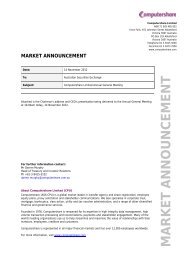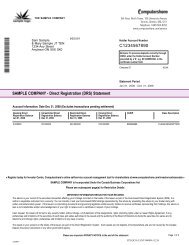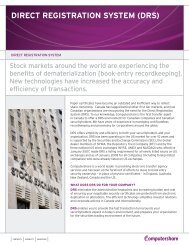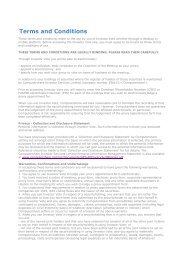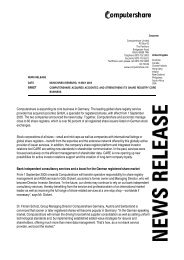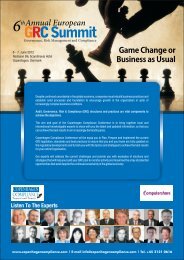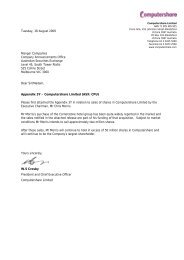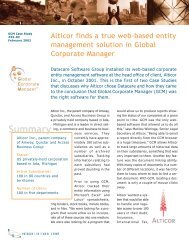COMPUTERSHARE ANNUAL REPORT 2008
COMPUTERSHARE ANNUAL REPORT 2008
COMPUTERSHARE ANNUAL REPORT 2008
Create successful ePaper yourself
Turn your PDF publications into a flip-book with our unique Google optimized e-Paper software.
Notes to the Financial StatementsThe following table summarises the interest rate risk for the parent entity, together with effective interest rates as at thebalance date.FloatinginterestrateNoninterestbearingAs at 30 June <strong>2008</strong> As at 30 June 2007TotalAve interestrateFloatinginterestrateNon- interestbearingTotalAve interestrate$000 $000 $000 % $000 $000 $000 %Financial assetsCash 7,842 - 7,842 5.75 597 - 597 6.00Intercompanyreceivables 14,283 269,080 283,363 2.75 10,099 85,166 95,265 4.75Financial liabilitiesIntercompanypayables and loans 72,597 679,335 751,932 5.75 70,679 149,361 220,040 6.00The sensitivity of the profit and loss statement to interest rate movements is the effect of assumed reasonably possible changesin interest rate for one year, based on the on-balance sheet floating rate financial assets and liabilities as at 30 June. The totalsensitivity is based on the assumption that there are parallel shifts in the yield curve and do not take into account actions thatManagement may take to mitigate the effect of such changes.Management judgements of reasonably possible movements in interest rates have been based on 200 basis point movementsaround the 12 month market rate as at 30 June for all regions. The assumptions and methods used in performing the sensitivityanalysis did not change from the previous periods.The sensitivity to a reasonably possible increase in interest rates, with all other variables held constant, of the profit and lossstatement is a decrease to profit of $10.6 million (2007: $0.9 million). This sensitivity calculation does not include the impact ofclient balances or the related derivatives.The sensitivity to a reasonably possible decrease in interest rates, with all other variables held constant, of the profit and lossstatement is an increase to profit of $1.0 million (2007: $0.1 million). This sensitivity calculation does not include the impact of clientbalances or the related derivatives.Client balances have been excluded from the sensitivity analysis as they are not reflected on the Group’s balance sheet. Interestincome is earned on these balances at a floating interest rate.The above sensitivity analysis does not reflect the future impact on the profit and loss statement should the reasonably possiblechanges in interest rates occur as the calculations are based on balances held as at 30 June.(b) Foreign exchange riskForeign exchange risk arises from future commercial transactions and recognised assets and liabilities denominated in a currencythat is not the entity’s functional currency.Entities within the Group typically enter into external transactions and recognise external assets and liabilities that are denominatedin their functional currency. Whilst a number of entities within the Group hold external bank account balances in a currency which isnot their local functional currency these balances do not expose the Group to significant foreign exchange risk.Foreign exchange risk also arises from net investments in foreign operations held in the United Kingdom, Canada, Europe and AsiaPacific. Accordingly, the Group’s balance sheet can be affected significantly by movements in the relevant currency exchange ratewhen translating into Computershare’s presentation currency, the United States dollar. Intercompany balances denominated in acurrency that is not the entity’s functional currency are designated as a hedge of the net investment in foreign operations. Theconsolidated entity also has debt that is designated as a hedge of the net investment in foreign operations. On consolidation, anyexchange gains or losses on these balances are transferred to the foreign currency translation reserve.The Parent entity’s post tax profit for the year would have been $3.6 million (2007: $2.8 million) higher/$ 4.4 million(2007: $3.4 million) lower had the Australian dollar strengthened/weakened by 10% against the British Pound and Canadian Dollaras a result of the foreign currency denominated intercompany balances. These balances are eliminated on consolidation and asthey are designated as part of the hedge of net investment these foreign currency gains or losses are taken to foreign currencytranslation reserve on consolidation.(c) Credit riskCredit exposure represents the extent of credit related losses that the consolidated entity may be subject to on amounts to bereceived from financial assets. The consolidated entity, while exposed to credit related losses in the event of non-payment by clients,does not expect any clients to fail to meet their obligations. The Group’s trading terms do not generally include the requirement forcustomers to provide collateral as security for financial assets and accordingly, the consolidated entity does not hold any collateralas security.The consolidated entity’s exposure to credit risk is as indicated by the carrying amounts of its financial assets. Concentrations ofcredit risk exist when clients have similar economic characteristics that would cause their ability to meet contractual obligations tobe similarly affected by changes in economic or other conditions.PAGE 80 Computershare Annual Report <strong>2008</strong>



